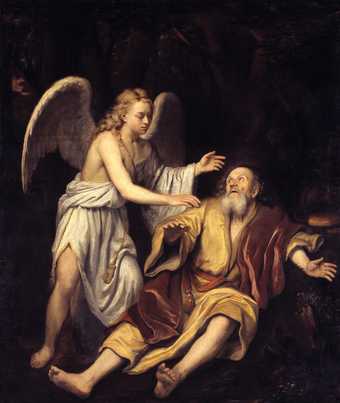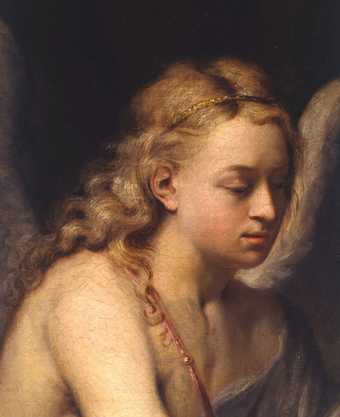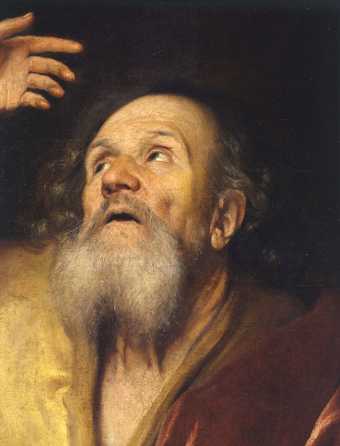This painting is in oil paint on canvas measuring 1775 x 1486 mm (figs.1–3). The canvas is made up of two pieces of plain woven linen, joined together at a seam across the centre (fig.4). The top piece is 895 mm in height and the lower piece 880 mm, and the weave on the two pieces looks very similar: the top piece has 15.5 vertical and 15.5 horizontal threads per square centimetre, while the lower has 13–15 vertical and 15.5 horizontal. The threads of the canvas are uneven in thickness with many slubs.
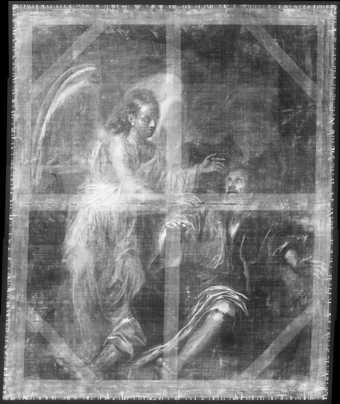
Fig.4
X-radiograph of Elijah and the Angel 1672
There is cusping of the canvas weave on all sides of the painting.1 The original tacking margins are no longer present on the edges of the stretcher. The painting has a glue composition lining, which from its style probably dates from the late nineteenth century. A restorer’s label on the back of the stretcher, which looks contemporary with the lining, records ‘L. B. TAYLOR / 18 Ir [?…..] Sq. / MANCHESTER / EXPERT ART / PICTURE / RESTORER.’, printed on a shield-shaped label. Bar-cracks parallel to the edges of the painting indicate that the original stretcher bars were 63 mm wide (2 ½ inches). At the top of the picture the bar mark is 89 mm (3 ½ inches) from the actual top edge of the painting; examination of the X-radiograph gives the explanation that the top tacking margin was folded out to form part of the picture plane some time after the painting was finished. It is supported by the lining and has been overpainted to look like a continuation of the original image. The painting’s original dimensions would therefore have been approximately 25 mm less in height, making them approximately 1750 x 1486 mm.
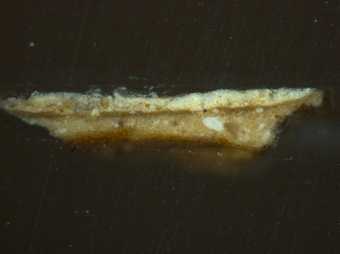
Fig.5
Cross-section through a shaded area of Elijah’s yellow garment, photographed at x160 magnification. From the bottom: traces of brown animal glue size which would have been applied to the canvas before the ground was applied; beige coloured ground; grey priming; yellow paint of garment; varnish
The ground is beige coloured and it was applied to the sized canvas in a fairly thick, smooth layer. The ground appears to have been sealed with thin, oil-based priming (fig.5). The priming contains small amounts of lead white, chalk, black and earth colours to give a dull grey tone.2 The artist may have developed it into a dead-colouring, keeping it very thin in light toned areas such as the white and yellow drapery but applying it thickly in areas such as the column and the dark background to get a feel for the shape, the internal space and the lighting of the composition (figs.6–7). No underdrawing is evident with the microscope or infrared.
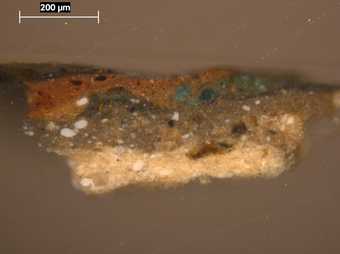
Fig.6
Cross-section through the red torus of the column, photographed at x160 magnification. From the bottom: beige coloured ground; grey priming, thicker that in fig.5; several opaque coloured layers, applied wet-in-wet; reddish brown paint of column; varnish and a glaze of later retouching
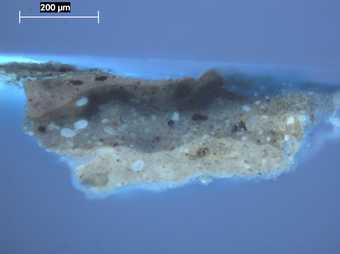
Fig.7
Cross-section through the red torus of the column, photographed at x160 magnification in ultraviolet light. From the bottom: beige coloured ground; grey priming, thicker than in fig.5; several opaque coloured layers, applied wet-in-wet; reddish brown paint of column; varnish and a glaze of later retouching
In general the paint is of a creamy consistency and was applied thickly with vigorous brushwork very much in the manner of Bol and Rembrandt, with whose work Kneller would have been familiar during his years of training in Amsterdam.
The structure varies from area to area. For the red drapery Kneller laid in thick white lead for the highlights and let them dry. Then the whole area was glazed with red lake paint, occasionally mixed with a little lead white. Up to three layers of glaze were applied for the deepest shadows and it would appear from examination of the cross-section that different types of red lake pigment were incorporated into each layer (figs.8–9).3
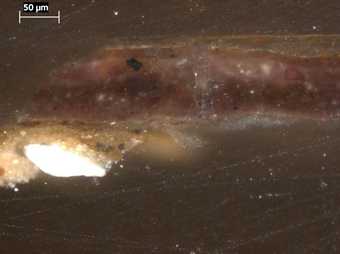
Fig.8
Cross-section through a deep shadow in Elijah’s red cloak, photographed at x320 magnification. From the bottom: (ground hardly taken in this sample); grey priming; dark red, semi-translucent paint; lighter red, semi-translucent paint; slightly brownish red, semi-translucent paint; varnish
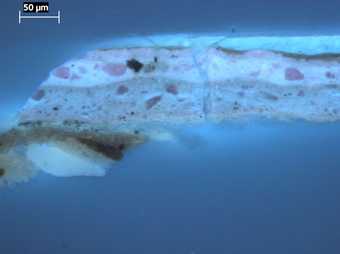
Fig.9
Cross-section through a deep shadow in Elijah’s red cloak, photographed at x320 magnification in ultraviolet light. From the bottom: (ground hardly taken in this sample); grey priming; dark red, semi-translucent paint; lighter red, semi-translucent paint; slightly brownish red, semi-translucent paint; varnish
Examination of cross-sections in UV light indicates that the medium for most of this glaze-work was oleo-resinous. The yellow drapery is based on mixtures of lead tin yellow with yellow earth colours. The garment was built up wet-in-wet. Cross-sections from some of the dark areas in the background reveal very bright, solid underlayers which play no part in the final composition; for example the torus of the column on the right is underpainted with very bright, opaque green based on the mineral pigment malachite, some of it the variety known as spherical (fig.10). It is not clear whether these were false starts for a different sort of background or part of the process of painting. They are not clarified by the X-radiograph, which reveals no significant alterations to the visible composition.
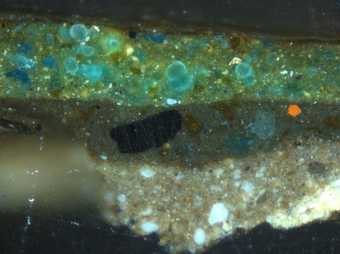
Fig.10
Cross-section through dark foliage at the right edge, photographed at x320 magnification. From the bottom: fragment of beige coloured ground; grey riming; dark green paint; bright green paint, which contains malachite, some of it spherical, green lake and blue verditer; thin, dark brown paint; varnish
An interesting feature of the light, opaque areas – the flesh-tones, the white and the yellow drapery – is the admixture of significant quantities of blue pigment into the paint. The blue is a mixture of smalt and ultramarine ash.4 The function of these light blue pigments may be more than tonal: smalt is known to have been used in this capacity as a drier for the oil and also as a transparent filler to add bulk to the paint without making it too opaque. Artists known to have used smalt in this way are Rembrandt, Van Ruisdael and others of the Dutch school.
The painting is covered with several thick layers of natural resin varnish, which have discoloured to a mellow brown, although they are still translucent.
October 2004

